Minnesota
MILLE LACS Band of CHIPPEWA INDIANS |
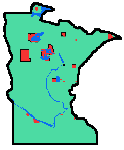 |
|---|---|
|
Federally recognized
Mille Lacs, Aitkin, Crow Wing and Pine counties, Minnesota NOTE: While most of these reservation statistics come from tribal officers, as indicated here certain figures were obtained by Tiller from the BIA for Mille Lacs. Mille Lacs has taken the lead in legal actions to try to regain and preserve land, water, hunting, fishing and gathering rights reserved to Ojibwe people under several land cession treaties and Executive Orders. Mille Lacs land history and leadership in the environmental and treaty rights struggles of Great Lakes native peoples is told in a booklet prepared by the Great Lakes Indian Fish and Wildlife Commission, available via a Native environmental rights index web page. Fulltexts of treaties affecting Mille Lacs, and a thorough discussion by the leading expert of the current issues in the Mille Lacs hunting-fishing rights lawsuit will be found on Minnesota Treaties page.
Maude Kegg, elder, of Mille Lacs has been vitally important in preserving Anishnaabemowin -- Ojibwe language -- in working with linguists and a tribal recording project that has produced a low-cost A CONCISE DICTIONARY OF MINNESOTA OJIBWE by John D. Nichols and Earl Nyholm, with the tribe contributing the linguistic computer database construction and subsidizing some of the printing costs (to the University of Minnesota Press). Her memories of her girlhood, raised traditionally near Mille Lacs, are published in PORTAGE LAKE: MEMORIES OF AN OJIBWE CHILDHOOD, Maude Kegg, ed. John D. Mitchell, in both the U.S. and Canada. Maude's beadwork is especially famous, and she is honored here by the dedication of MANIDOOMINENS: Sacred Seeds the art section of beadwork in her honor.
But what it means for the Mille Lacs Band is that land values in the area are highly inflated by the very profitable year-round tourist industry. The ice house city represents a wide range of profitable activities for non-Indian tourist enterprises and for all local retail outlets. Most of the ice houses are owned and rented and emplaced on the ice, with electrical, fuel and food deliveries by large snow vehicle over almost 1,000 miles of snow-cleared roads the locals maintain over the lake ice. Where trendy Twin Cities ice-partying "fishermen" have constructed extremely luxurious ice houses they themselves own, the locals make money on storage rentals over the 9 month period when the lake's surface is water. Large fees are charged for emplacement, ice road maintenance, power, fuel, and food supplies -- and booze of course. What all this adds up to is difficult and expensive land buy-backs for the tribe, where possible at all. Some band members have complained about the tribal policy of investing most casino revenues -- even though there are now jobs for all. They want more cash distributions, less invested in the future. This has become a political issue in elections of band officers. Another Mille Lacs political issue: there are a number of Minnesota Ojibwe families who trace their direct ancestry to a band with deep roots -- some of the deepest -- in local Ojibwe history: Sandy Lake Band. The Sandy Lake parcel -- far to the north of the rest of the Mille Lacs land parcels -- is presently registered to Mille Lacs, as a part of its federally-recognized tribal land. Sandy Lake Band member families are living there now, as they have for hundreds of years, and there are old burial grounds there that members have taken direct action to protect against road builders and developers. Sandy Lake Band is petitioning the BIA to allow them independent existence as a Minnesota Ojibwe tribe on the same footing as others (many of whom are more recent occupants of present reservation locations.) They tell their story -- their history, their current set up for self-government, their struggles for federal recognition -- on their own web site. | |
 Mille Lacs elder and beadworker Batiste Sam worked out, in beads, this leaf pattern logo, which is created in ceramic tiles to surface the front of the new
Mille Lacs elder and beadworker Batiste Sam worked out, in beads, this leaf pattern logo, which is created in ceramic tiles to surface the front of the new 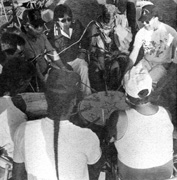 Little Otter Singers and drum group of Mille Lacs -- Pete Gahbow (lead), Art Gahbow, Bill
Gahbow (Drumkeeper and Drumwarmer #1), Bill Erik (Drumwarmer #2), Tom Benjamin (Drumwarmer #3), Larry Smallwood, Darren Moose, Jard Gahbow, Ron White, Joe Cominghay. Little Otter was named by Pete Gahbow, when crossing the Little Otter River once driving along. The drum group
is featured on a 1990 recording of drum music world wide, put together by famed Grateful Dead drummer Mickey Hart.
Little Otter Singers and drum group of Mille Lacs -- Pete Gahbow (lead), Art Gahbow, Bill
Gahbow (Drumkeeper and Drumwarmer #1), Bill Erik (Drumwarmer #2), Tom Benjamin (Drumwarmer #3), Larry Smallwood, Darren Moose, Jard Gahbow, Ron White, Joe Cominghay. Little Otter was named by Pete Gahbow, when crossing the Little Otter River once driving along. The drum group
is featured on a 1990 recording of drum music world wide, put together by famed Grateful Dead drummer Mickey Hart. 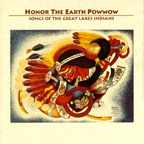 Little Otter has the opening song -- Grand Entry to the powwow naturally -- and another song on the "Honor the Earth Powwow" recording (1990 release) Hart put together in a 1989 visit to that powwow, held every year in Wisconsin by the Three Fires Society. Also featured are drums from other tribes of Wisconsin, Michigan and Canada. The album cover is the painting "Chippewa Dancer" (1970) by Red Laker
Little Otter has the opening song -- Grand Entry to the powwow naturally -- and another song on the "Honor the Earth Powwow" recording (1990 release) Hart put together in a 1989 visit to that powwow, held every year in Wisconsin by the Three Fires Society. Also featured are drums from other tribes of Wisconsin, Michigan and Canada. The album cover is the painting "Chippewa Dancer" (1970) by Red Laker 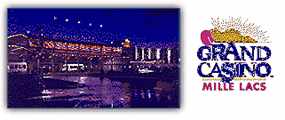 Like all other Minnesota tribes, Mille Lacs has enjoyed the recent bounty of casino money, possible because of Native sovereignty. Mille Lacs owns 2 casinos, that are managed by
Like all other Minnesota tribes, Mille Lacs has enjoyed the recent bounty of casino money, possible because of Native sovereignty. Mille Lacs owns 2 casinos, that are managed by 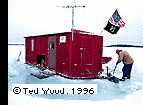 Photographer-writer Ted Wood photographed this luxurious ice house, complete with TV antenna, and American and "party time" flags, one of some 8,000 winter fishing icehouses that form a city on Lake Mille Lacs when the bitter Minnesota winters freeze its waters to a sturdy surface 6 - 8 feet thick. The winter ice house city -- larger than any nearby town, until you get south to the Twin Cities urban area -- is inhabited by a variety of recreational fishermen who indulge in other recreations and parties in the more luxurious "4 to 32 holers" -- referring to the number of holes cut down through the icy floor to the deep, chilly water, in the event the non-Indian inhabitants wish to bother with any fishing. This peculiar phenomenon, the IceHouse Party City, seems to have attracted no anthros -- but
Photographer-writer Ted Wood photographed this luxurious ice house, complete with TV antenna, and American and "party time" flags, one of some 8,000 winter fishing icehouses that form a city on Lake Mille Lacs when the bitter Minnesota winters freeze its waters to a sturdy surface 6 - 8 feet thick. The winter ice house city -- larger than any nearby town, until you get south to the Twin Cities urban area -- is inhabited by a variety of recreational fishermen who indulge in other recreations and parties in the more luxurious "4 to 32 holers" -- referring to the number of holes cut down through the icy floor to the deep, chilly water, in the event the non-Indian inhabitants wish to bother with any fishing. This peculiar phenomenon, the IceHouse Party City, seems to have attracted no anthros -- but